It’s already more than a month ago that I got back home from my journey to Jordan and I finally manage to write about it on my blog.
I had such an amazing time in the Middle East. Before going I was very excited but also became a little nervous and concerned after the plane crash over the Sinai peninsula at the end of October and the bomb attack in Beirut, Lebanon, which happened just the day before I left. I was asking myself if booking this trip was really a good idea. But a cancellation was never an option. Jordan is said to be a very safe country and it was on my travel wishlist for quite a long time. I also didn’t want the political situation in its neighbouring countries to keep me away from travelling there.
I am so glad that I went. I experienced a beautiful country with breathtaking sights and landscapes and very warm-hearted, hospitable locals. I always felt safe even when walking around alone at night.
Amman
After landing in Amman late at night I spent the following day by myself and explored the Citadel in depth which is also called Jabal el Qala’a. It is located on one of the 19 hills of Amman and from up there you have a terrific view of the Roman theatre and over the city. Probably the most famous part of the complex is the Temple of Hercules. There I met a lovely Canadian-Jordanian couple from Toronto with whom I talked for quite while. They had lived in Jordan for many years and still spend three months in the country every year. Later they drove me with their rental car to a café with a magnificent view of Amman which I really wanted to try out.
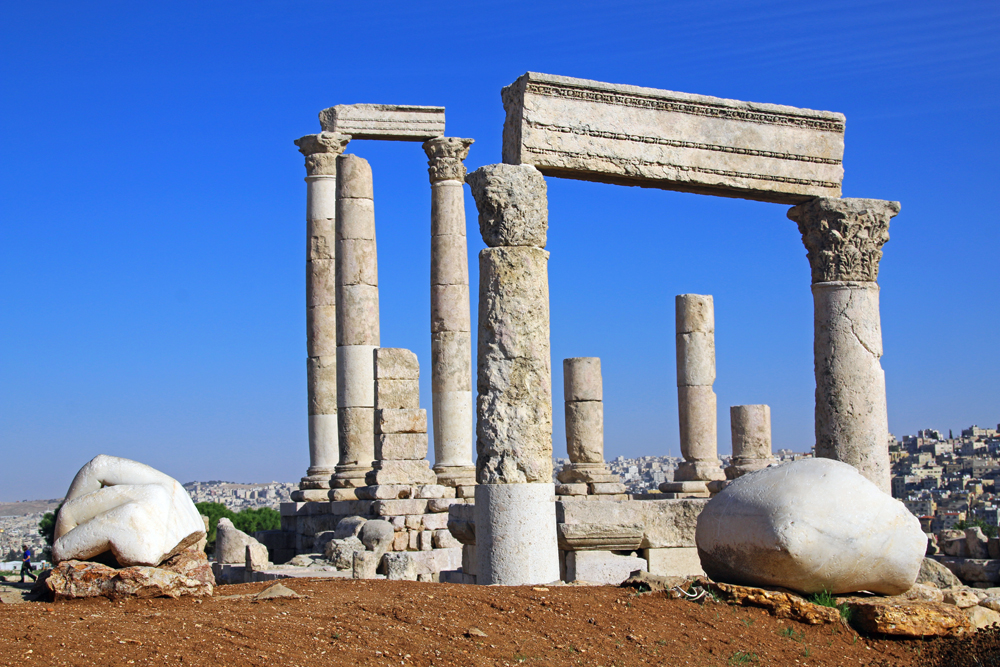 The Temple of Hercules on the citadel hill
The Temple of Hercules on the citadel hill
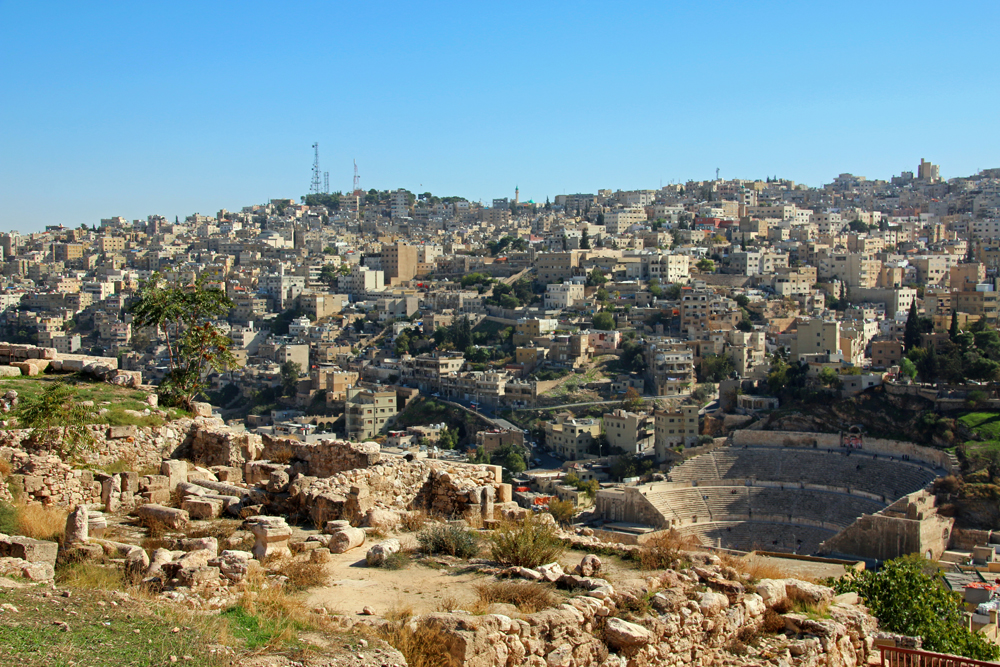 View of the Roman theatre and over Amman
View of the Roman theatre and over Amman
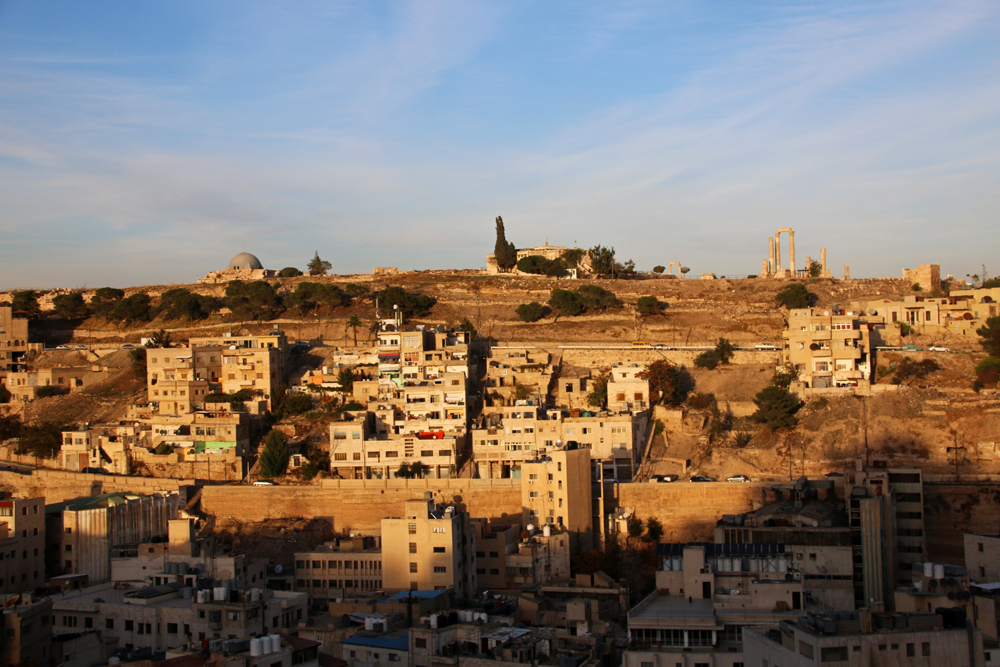 View of the citadel hill
View of the citadel hill
In the evening I met my group, consisting of 14 fellow travellers from Canada, the United States, Mexico, the United Kingdom, Italy, Belgium and Germany, plus our local guide Ayman from Amman who introduced us to the “rough Middle East”. He was fantastic, very funny and gave us an excellent insight into his home country, the culture, the people and the local cuisine.
The local cuisine
We ate and enjoyed all different types of local specialities: from Shawarma from a local streetfood vendour which we ate while walking to a nearby bar, Hummus, Falafel and Pita bread at a famous streetfood restaurant in Amman, where even the Jordanian King Abdullah and his wife Queen Rania sometimes dine, a buffet dinner in our hotel restaurant in Wādī Mūsá, Maqluba in a 2000 year-old cave, a dinner cooked in the ground of the desert of Wadi Rum, a barbecue on a chartered boat on the Read Sea, seafood in Aqaba to our fantastic farewell dinner in a fancy local restaurant in Amman.
Jerash
The first stop of our journey across Jordan was in Jerash where we wandered through the largest and most well-preserved Greco-Roman ruins outside of Rome. I knew that the complex in Jerash is large but I had no idea how vast it is. We explored the oval forum, the hippodrome, the Artemis and the Zeus temple, the Cardo Maximus, the Decumanus, the Roman market – also called Agora -, the bath, the amphitheatres, the churches and the gates.
 The oval forum in Jerash
The oval forum in Jerash
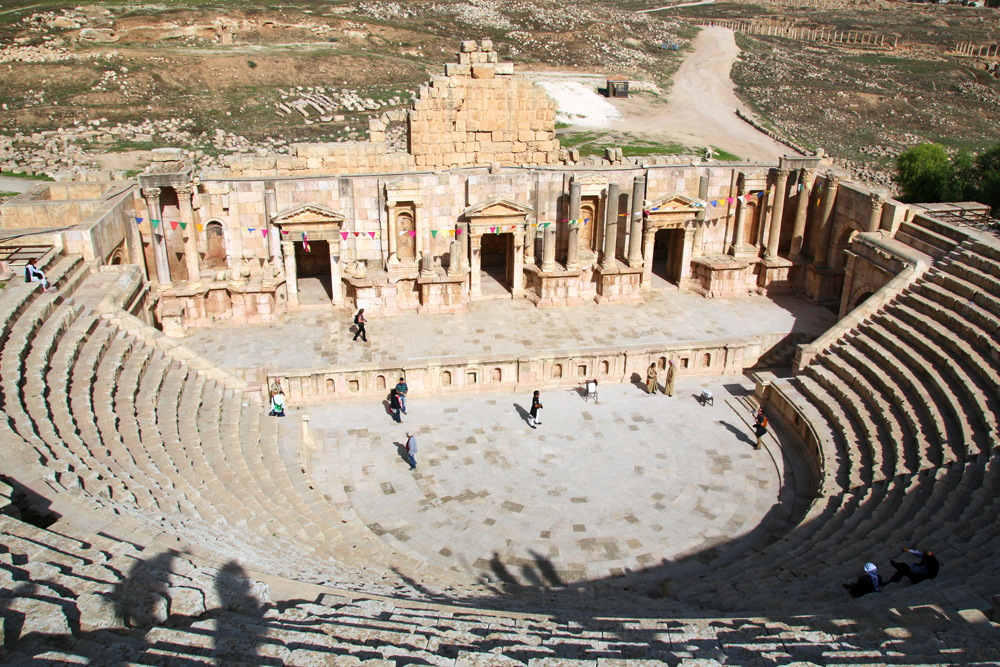 View from the southern amphitheatre
View from the southern amphitheatre
The Dead Sea
From Jerash we headed to the Dead Sea, the lowest point on Earth, and one of the saltiest waters on the globe. Its salt content of 31.5 percent is ten times higher than the one of the world oceans. Only the salt contents of Lac Retba in Senegal, Lake Assal in Djibouti, the Kara-Bogas-Gol in Turkmenistan, the Tuz Gölu in Turkey plus a few lakes in the Antarctic dry valleys are higher. We spent a relaxing afternoon at the Dead Sea, took a bath, floated at the surface and covered ourselves with the natural healing mud of the waters.
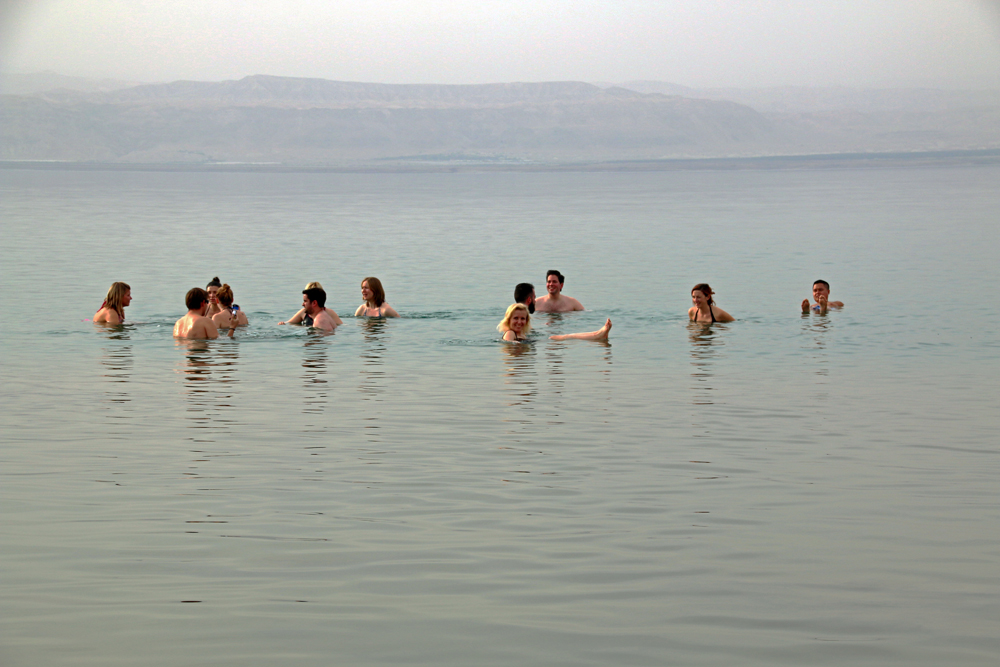 A bath in the Dead Sea
A bath in the Dead Sea
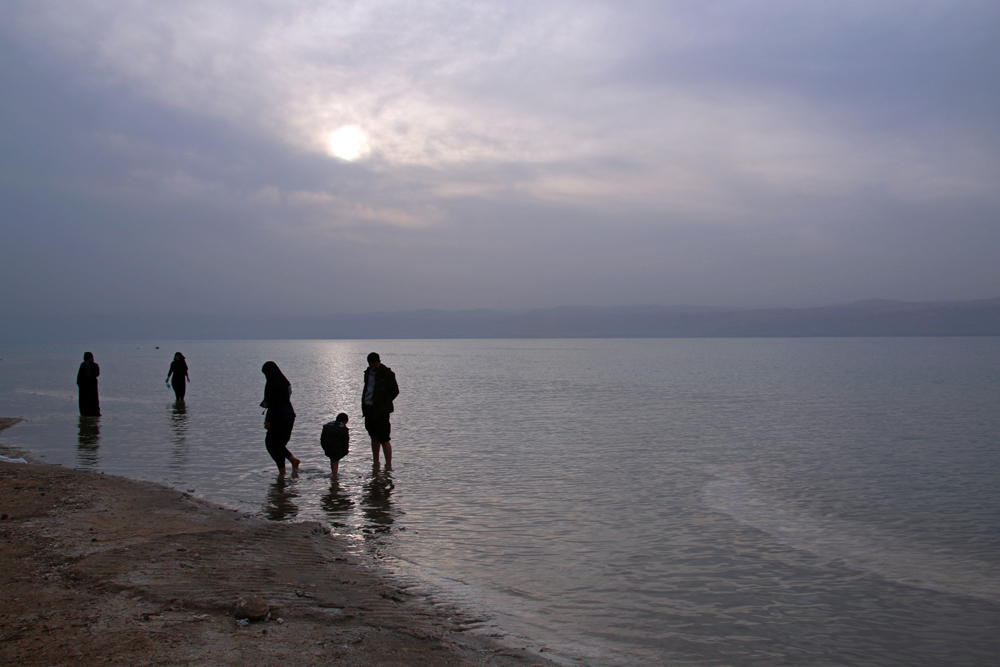 Locals at the Dead Sea at sunset
Locals at the Dead Sea at sunset
Mount Nebo
The following day we continued to Mount Nebo from where Moses once saw the Holy Land for the first time. On a clear day there must be a magnificent panorama of the valley of Jordan river, the Dead Sea and even the hills of Jerusalem but we weren’t lucky. It was cloudy and misty and we didn’t see much. According to legend Moses is buried on Mount Nebo. A mosaic reminds of him and prepared us for our next stop.
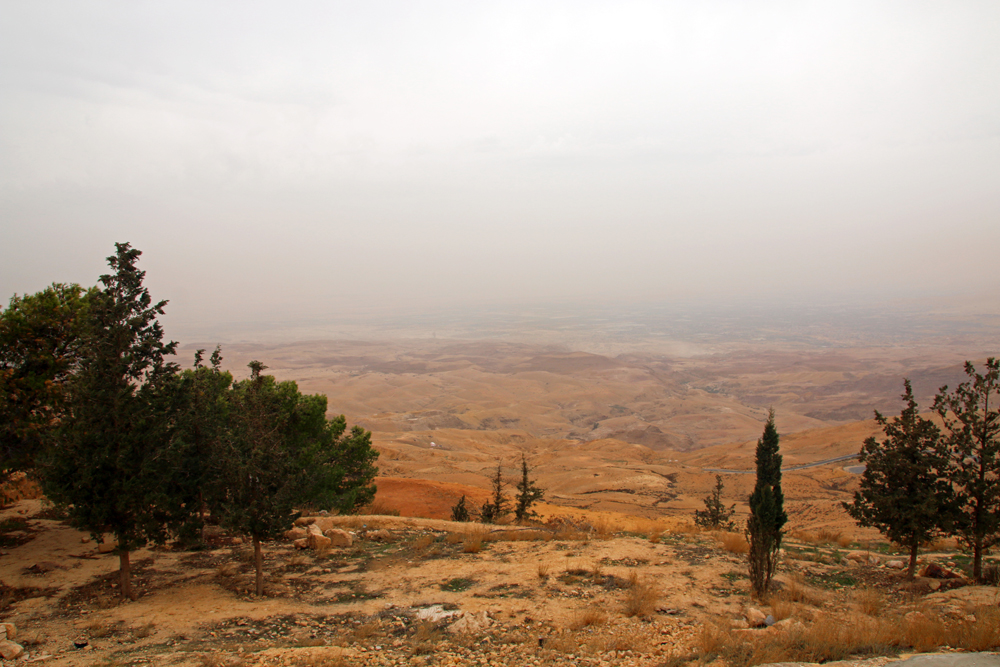 View of Mount Nebo on a cloudy day
View of Mount Nebo on a cloudy day
Madaba
Madaba is called the city of mosaics which are shown in more than a dozen churches. The best known is Madaba Mosaic Map, a floor mosaic located in the early Byzantine church of Saint George which was built in 1896. It’s the oldest original carthographic presentation of the Holy Land especially of Jerusalem and Palestine. That’s probably why this mosaic map is also called Palestine Mosaic. The other mosaics of Madaba must be very interesting as well but we visited only this one. Afterwards we had some free time which I used to wander through the streets of the city centre, to take a look into the handicraft shops and to mingle with the locals.
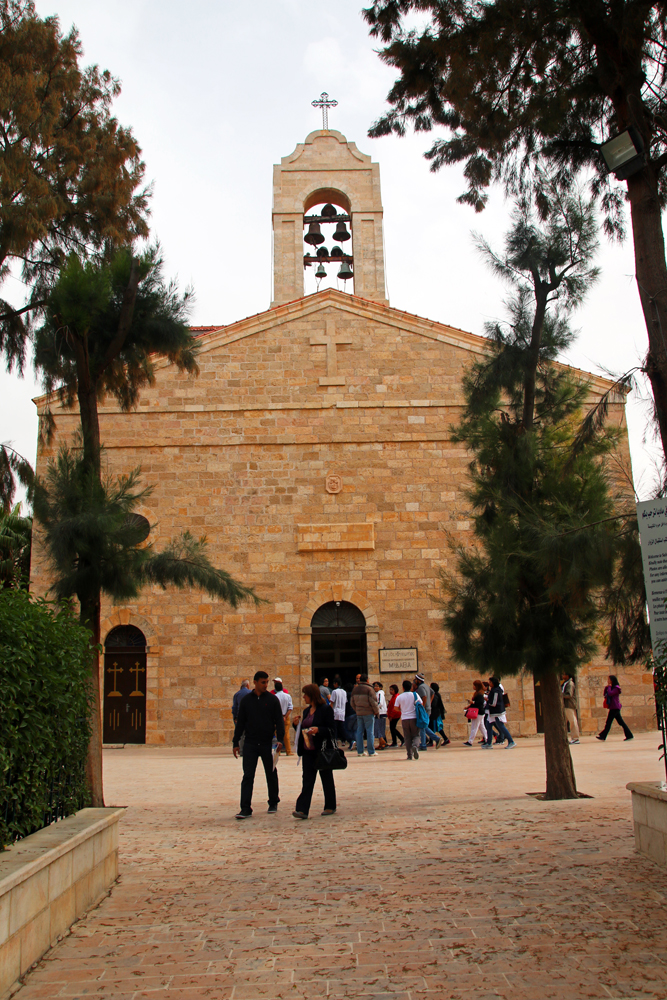 Church of Saint George in Madaba
Church of Saint George in Madaba
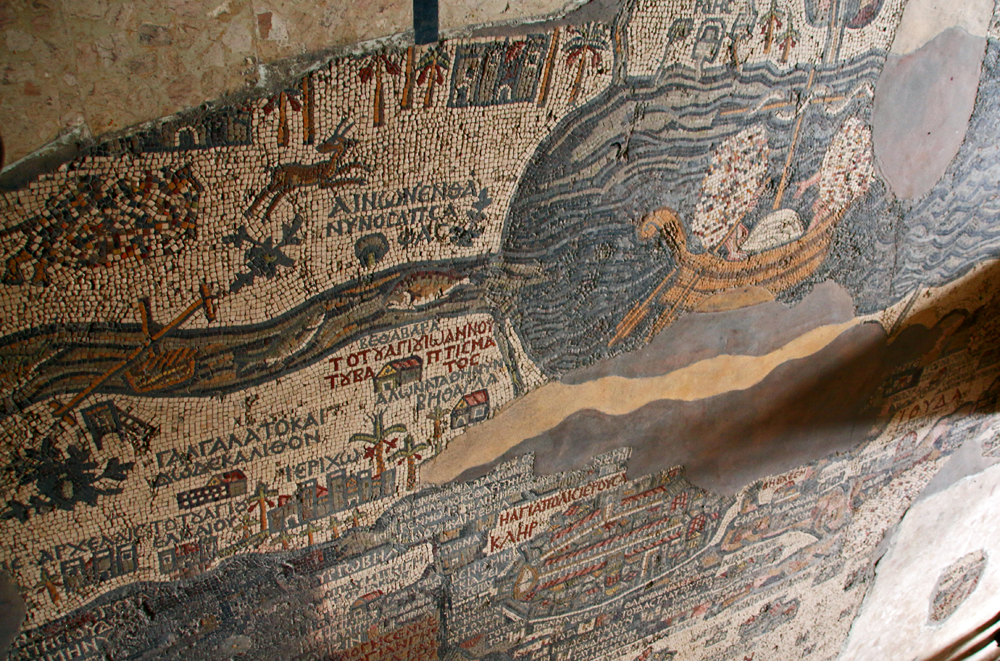 Section of the Madaba Mosaic Map in the church of Saint George
Section of the Madaba Mosaic Map in the church of Saint George
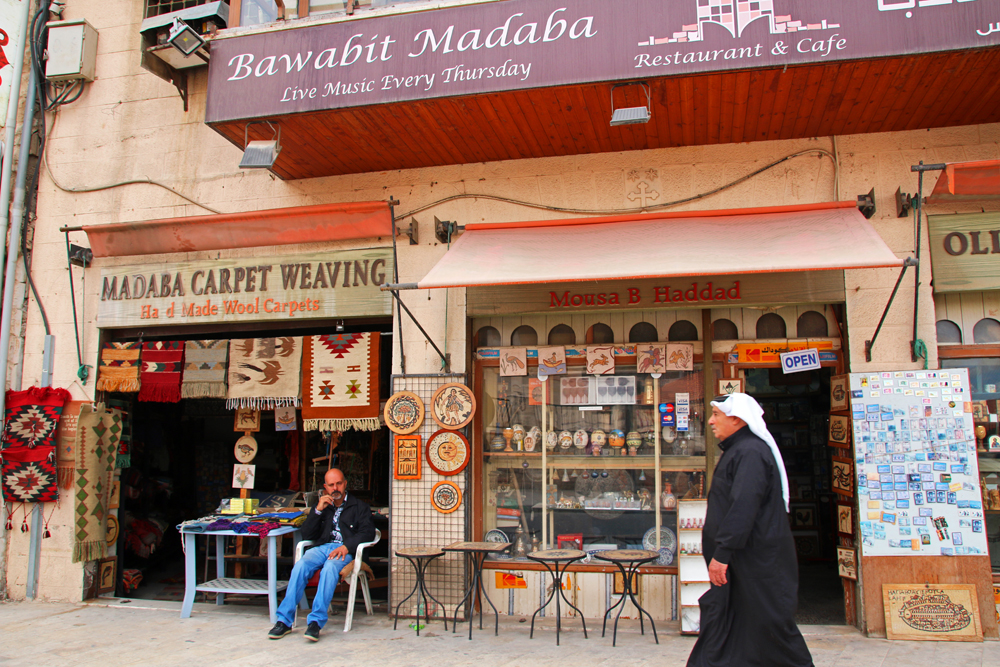 Locals in the streets of Madaba
Locals in the streets of Madaba
Karak
Next we were off to the crusader castle in Karak which was built in 1142 and was also called Crac des Moabites. It is located on the top of a hill of 950 metres. Due to its location it had a high strategic importance because it was possible to control both the Bedouins and the trade routes from Damascus to Egypt and Saudi Arabia from there. The castle complex is large with a maze of rooms and corridors and due to the low lighting it’s probably easy to get lost without a an experienced guide. After the guided tour we again had some time to explore the castle on our own. Fortunately none of us got lost.
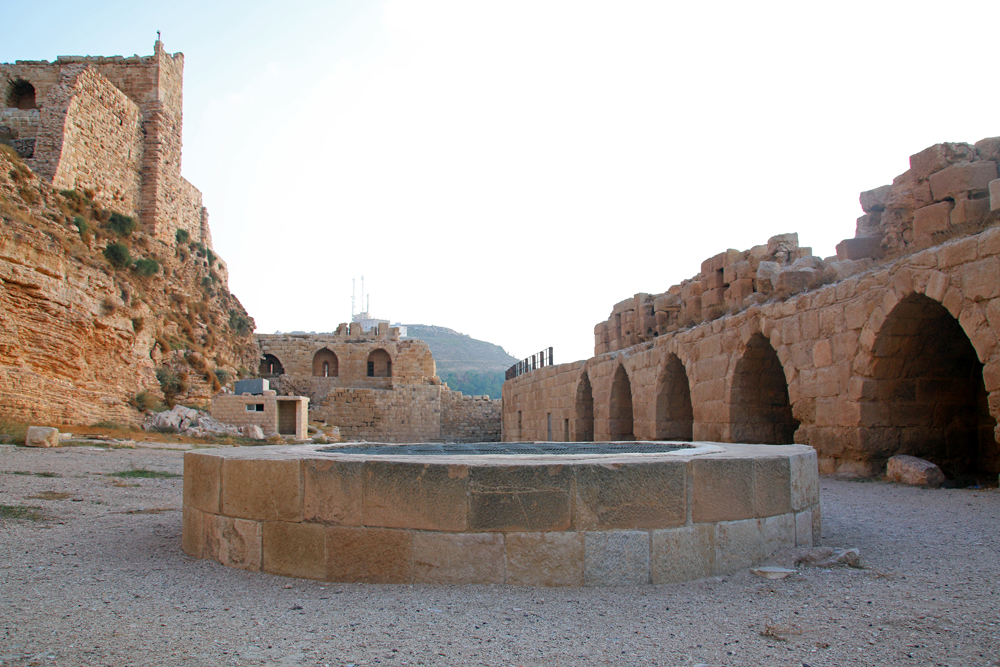 The crusader castle in Karak
The crusader castle in Karak
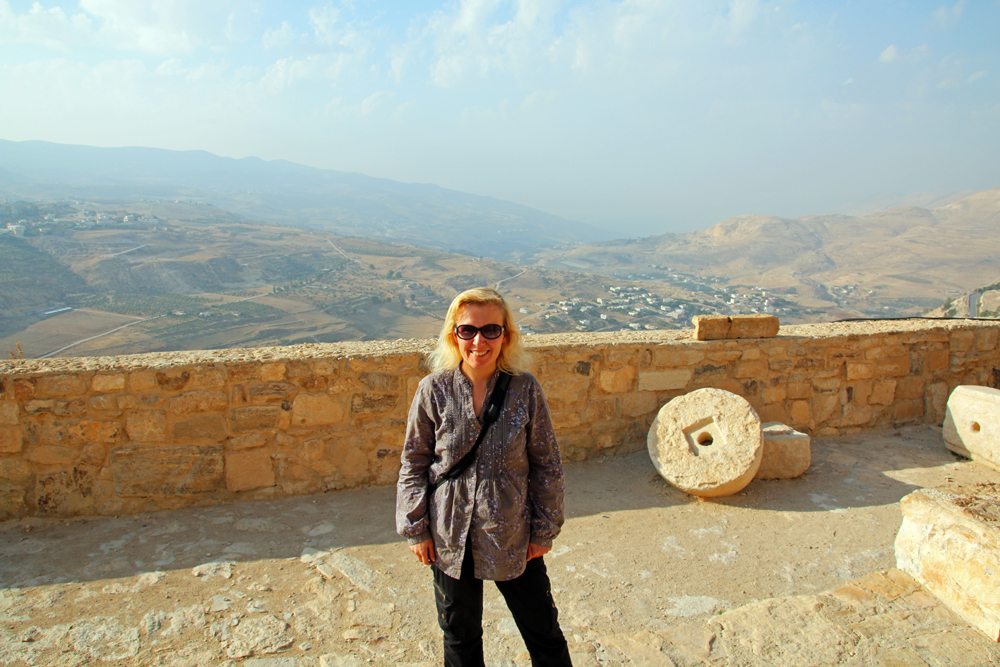
Petra
We got into Wādī Mūsá in the evening, right on time to experience Petra by night which takes place on Mondays, Wednesdays and Thursdays at 8.30 PM. The event started with a walk through a 1.2 kilometres long canyon, called the Siq, which was lit solely by countless of candle lights. At the end we arrived at the Treasury also illuminated by hundreds of candles. The scenery was accompanied by Bedouins singing and playing music and telling a story about Petra and the Nabateans plus a glas of traditional Bedouin mint tea. I had heard quite a few critical voices beforehand who said that Petra by night is not worth the money. However, we were the last ones who arrived at the Treasury and the last ones who left it – a fantastic tip of our Jordanian guide Ayman -, so that we had the Siq almost the whole time for ourselves. The atmosphere and scenery were truly an awe-inspiring experience and IMO definitely worth the money. If you decide to attend Petra by night definitely don’t miss to bring a tripod for your camera, you will need it.
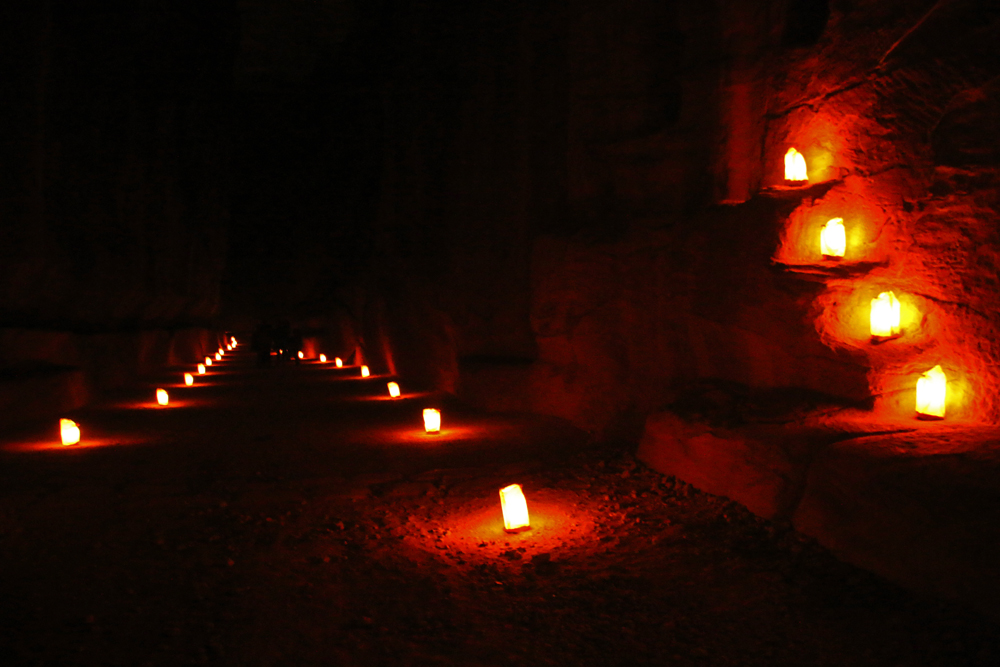 The illuminated Siq
The illuminated Siq
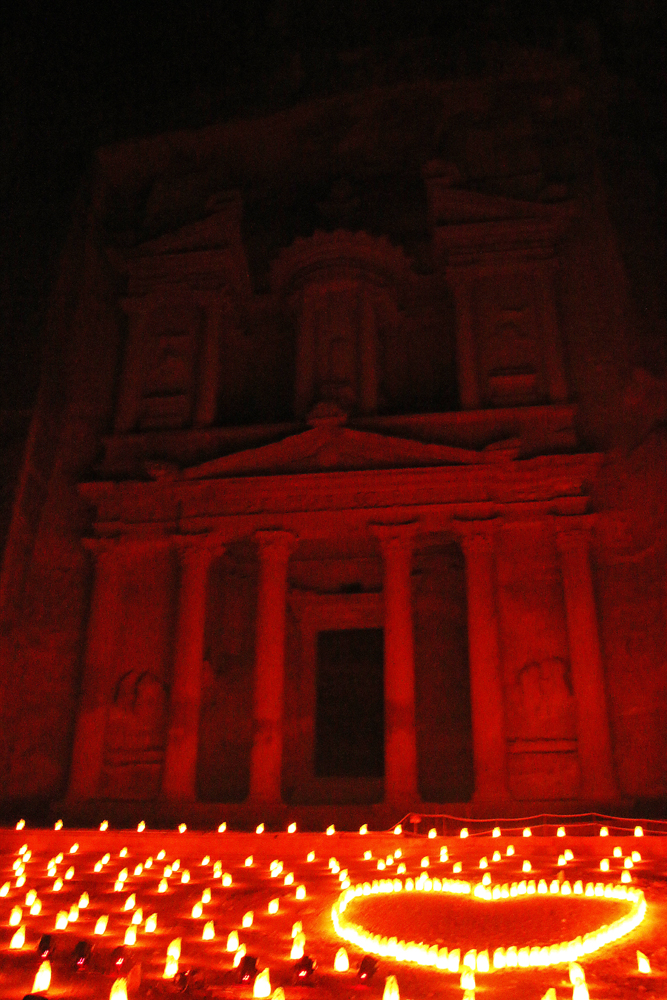 Petra by night
Petra by night
After a short night we started our walk through the Siq the next morning at 6 AM to be the first at the Treasury and it was definitely worth the effort. Again we were the only ones in the Siq and the very first ones at the Treasury where we spent quite some time to take photos and enjoy the scenery before other tourists arrived. Then we started our hike through almost the whole city of Petra whose trails stretches over 25 kilometres. We had originally planned to hike through whole Petra but due to a thunderstorm with heavy rain at midday the rocks were quite slippery so a few others and me refrained to climb up the last and steepest part to the viewpoint from where you can see the Treasury from above.
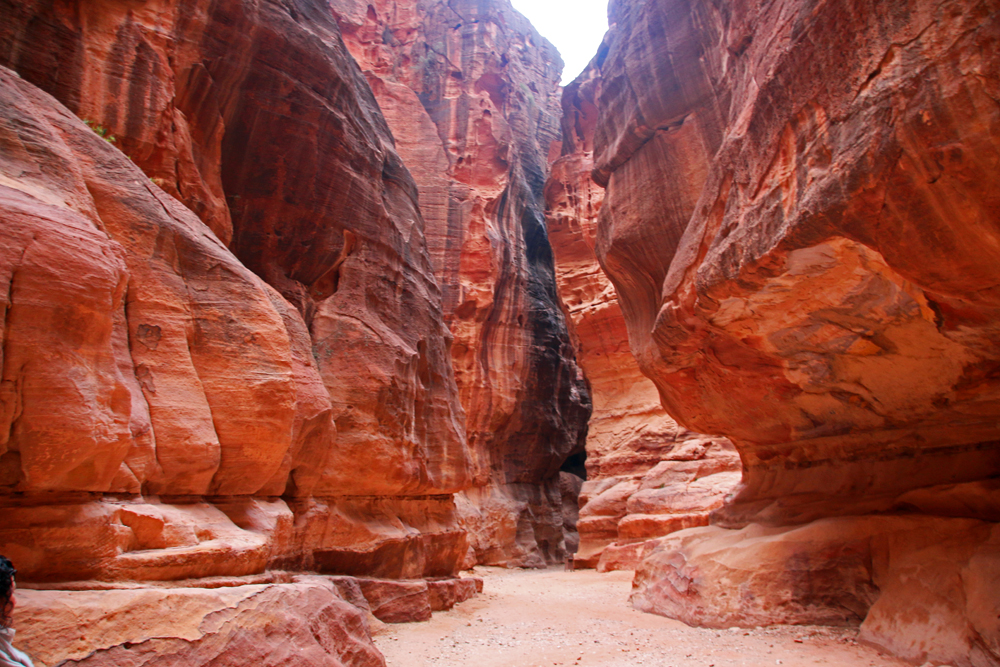 The Siq
The Siq
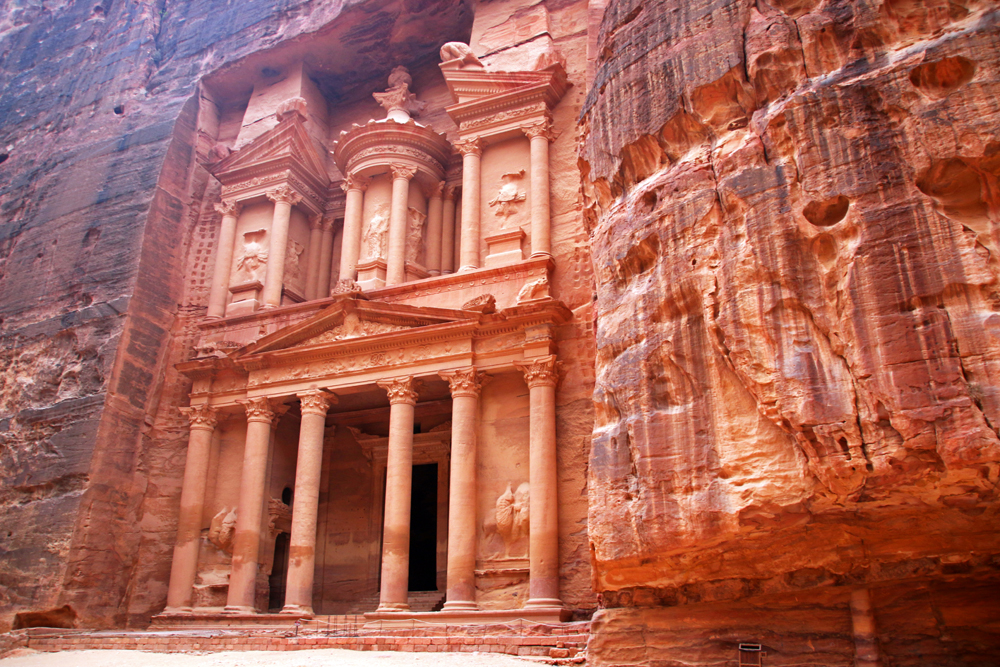 The Treasury in the early morning
The Treasury in the early morning
A Hammam experience
In the late afternoon four others of my group and me had an appointment at the hotel’s Hammam, separated strictly by gender. It wasn’t my first time in a Hammam but it was still quite an experience.
A few hours later we were picked up by Abdullah, a friend of Ayman, and taken to a 2000 year-old cave which was a burial chamber in former times. There we were served Maqluba followed by drinks and some dance moves.
Wadi Rum
The next day we drove into the desert of Wadi Rum. We took a three-hours 4×4 excursion with several stops in the desert and enjoyed the sunset from one of the high rocks. In the evening we drove back to our Bedouin camp where we were served a dinner, cooked in the grounds of the desert, and listened to some live Bedouin music. Later at night we left for a nightwalk into the desert where we collected firewood and made a campfire. We cooked tea and grilled marshmallows over the open fire and watched the million stars in the sky above us.
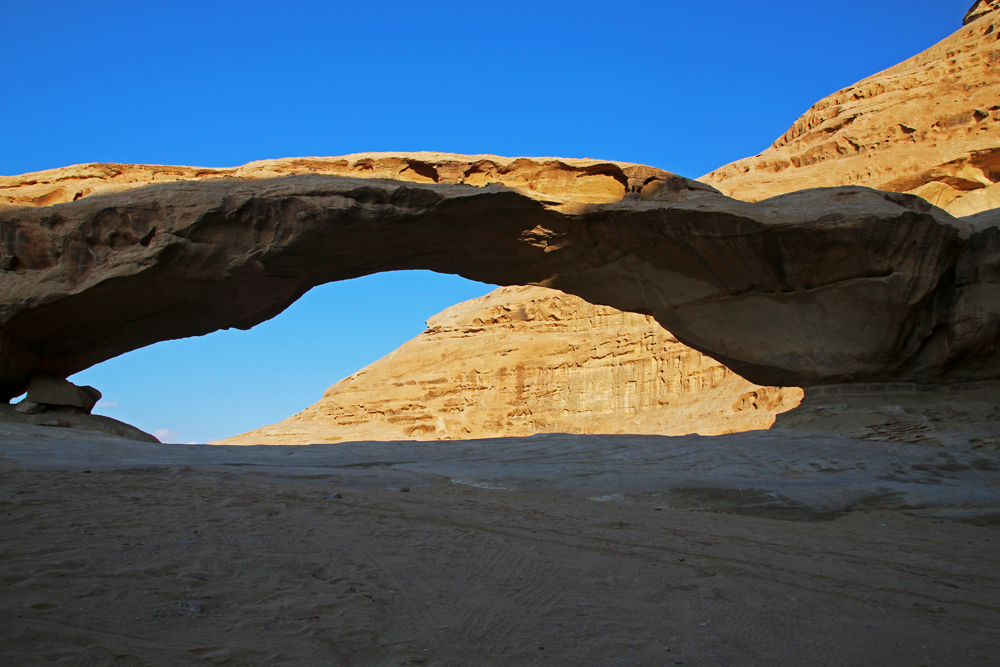 Rock formations in the desert of Wadi Rum
Rock formations in the desert of Wadi Rum
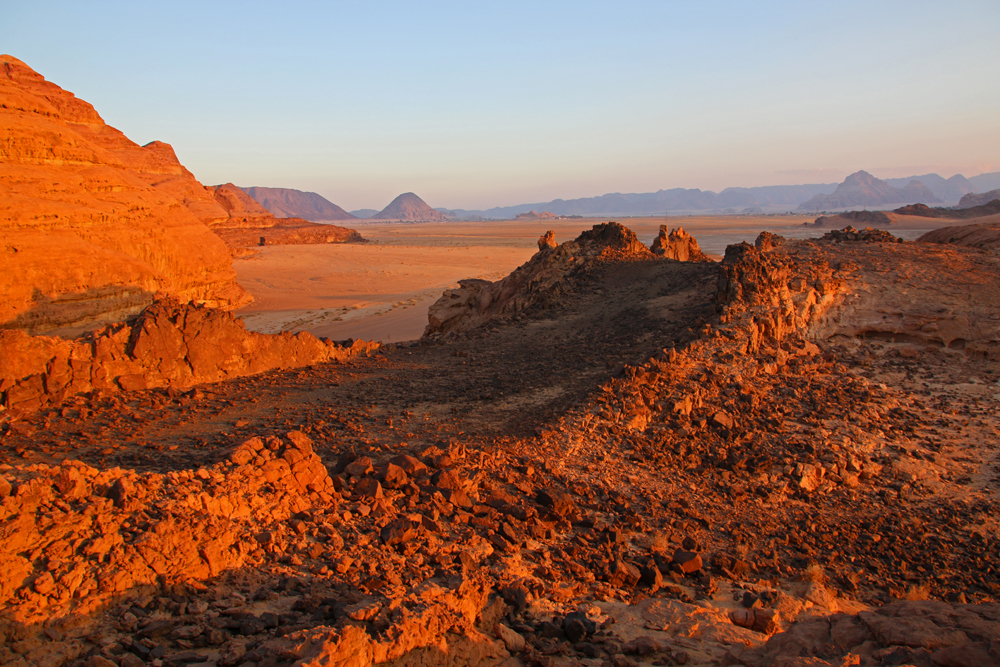 Sunset over Wadi Rum
Sunset over Wadi Rum
After another short night we left the camp the following morning at 5 AM to ride camels into the desert and watch the sunrise over Wadi Rum. On previous journeys I had watched the sunrise over Angkor Wat in Cambodia, from a boat on the river Ganges in Varanasi in India, and during my first camel ride up the Mingsha sand dunes in Dunhuang at the Chinese Silk Road in October 2014. But every time it is different and absolutely unique. This time we watched the sun rise from a place from where you have a panoramic view over the desert before we returned to the camp for breakfast.
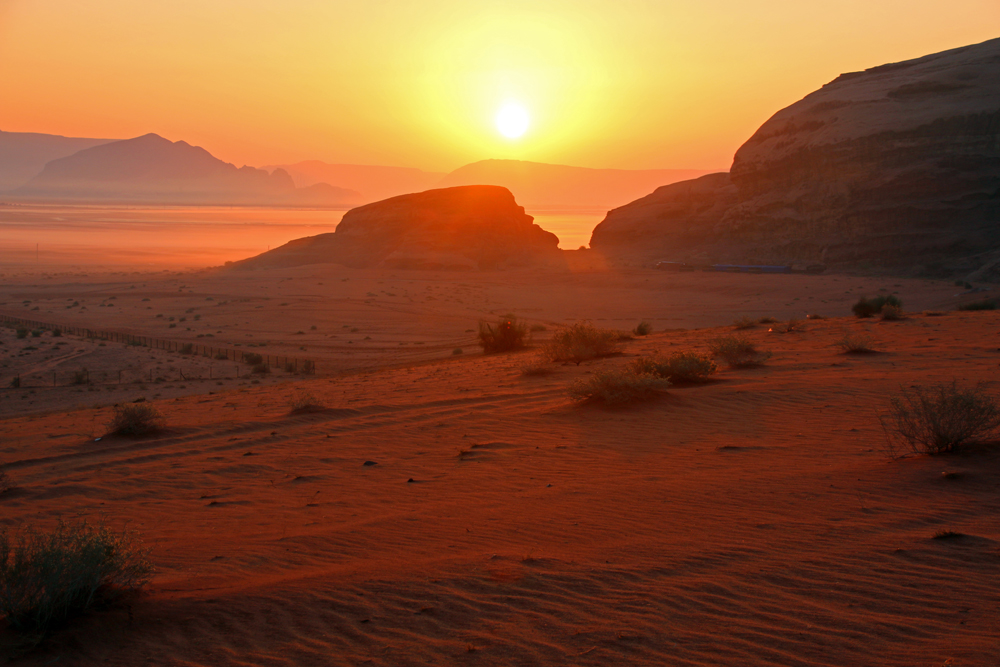 Sunrise over Wadi Rum
Sunrise over Wadi Rum
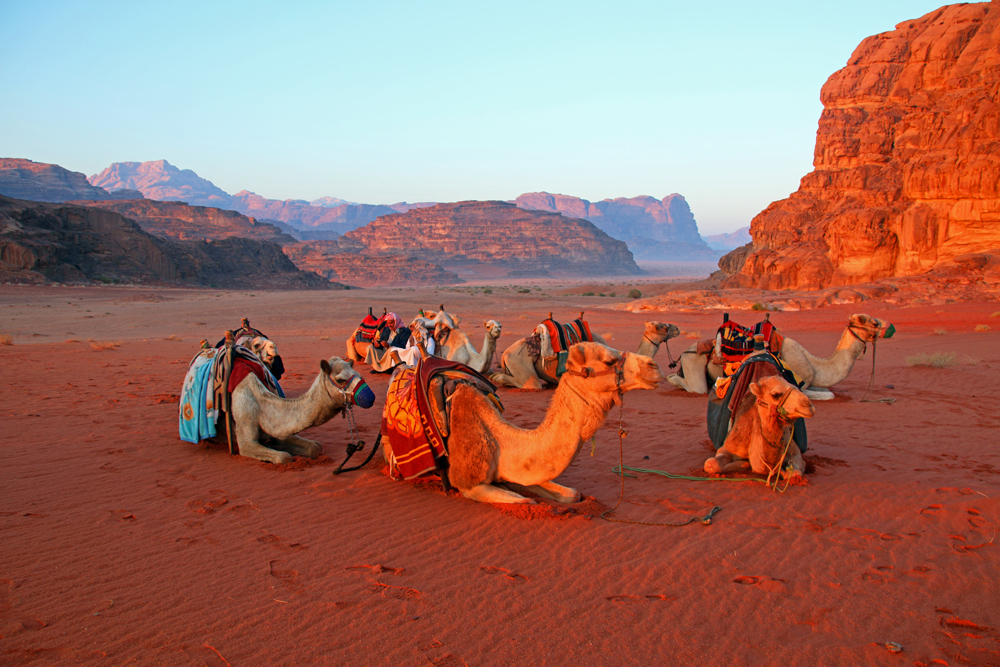
Aqaba
Afterwards we left Wadi Rum and headed to Aqaba at the Red Sea. There we chartered a private boat and spent a relaxing day at the sea,snorkelling and indulging a fantastic barbecue on board. In the evening we enjoyed seafood in a restaurant at the waterfront.
 Aqaba, seen from the boat
Aqaba, seen from the boat
The next day we drove back to Amman where we had a traditional dinner in a stylish local restaurant followed by our farewell party in a club in Amman.
While several of my travelmates left Jordan early the next morning I had the full day in Amman on my own. I visited the Roman theatre, strolled through the small alleys of downtown Amman and enjoyed good food and drinks at dawn in a restaurant overlooking Amman. At midnight I left to the airport and took the plane back home.
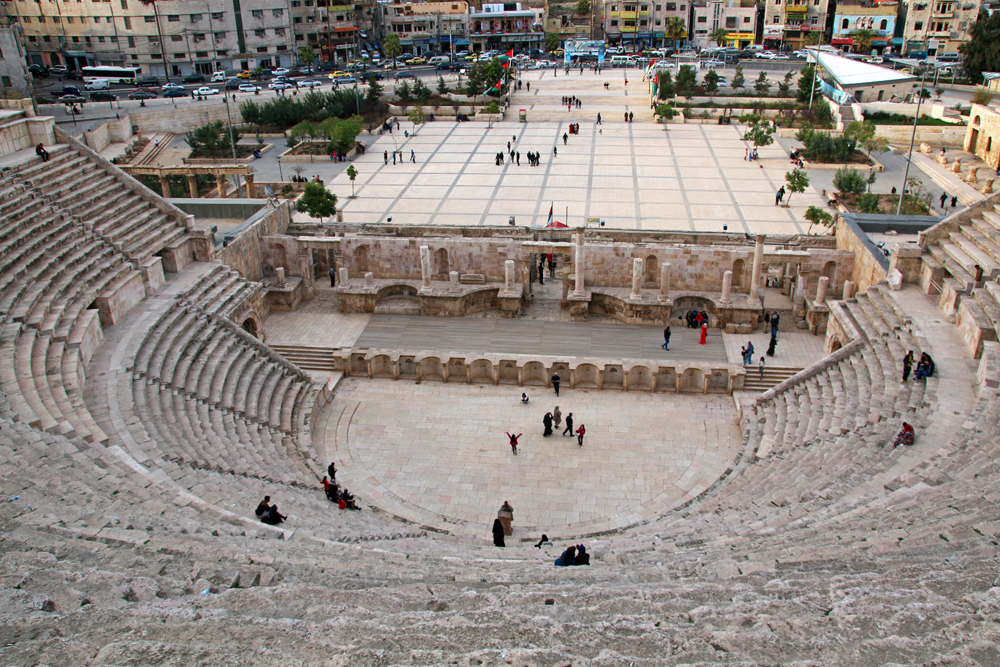 The Roman theatre in Amman
The Roman theatre in Amman
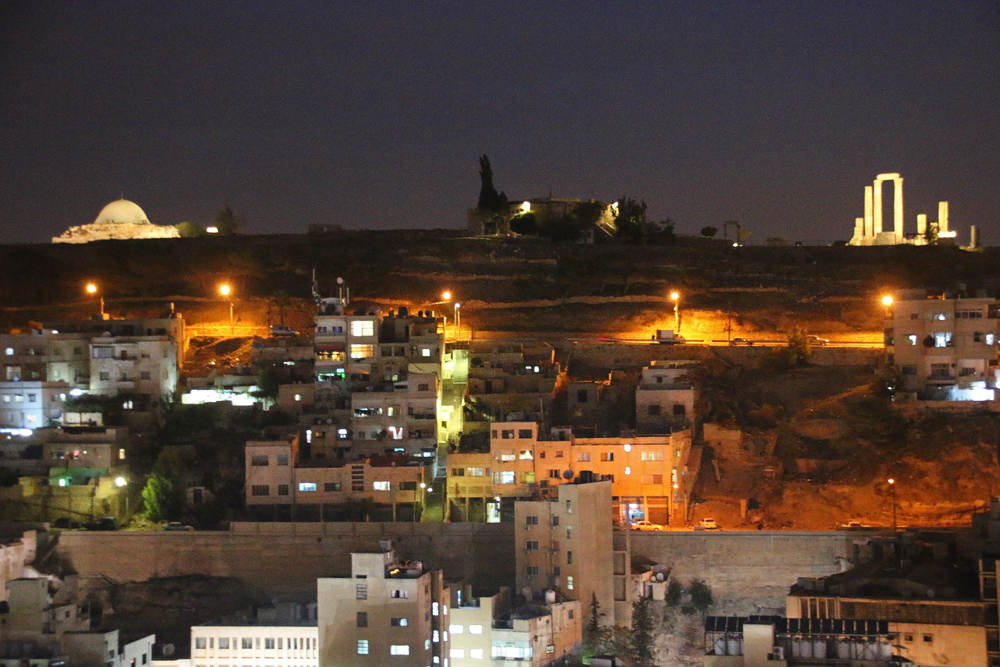 View of the citadel hill at night
View of the citadel hill at night
Jordan – the not so “rough Middle East”
My journey through the “rough Middle East” wasn’t as rough as announced for fun by our local Jordanian guide Amman. Despite the war in Syria and the turmoil in some other neighbouring countries, Jordan is a very safe country and now is a good time to go. There are fewer tourists than a few years ago so the sights aren’t as overcrowded as they maybe were five or ten years ago. The locals are charming and hospitable and the sights utterly amazing.
Have you been to Jordan? How did you like it?
Did you enjoy this post? Then please consider sharing it on social media, leave me a comment below and follow me on Facebook, Twitter, and Instagram.
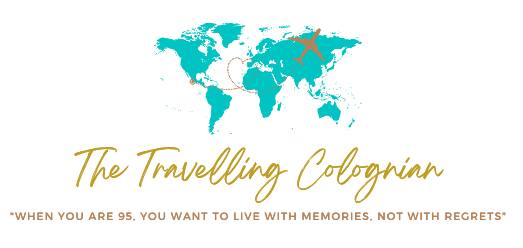
Tolle Reise und ein tolle Bericht. Ich glaube, ich wäre doch gerne dabei gewesen :)
Jordanien ist nicht aus der Welt. Und auf jeden Fall auch eine zweite Reise wert. ;)
Enjoyed this post very much! I have friends who recently traveled to Jordan and they did not do half of what you did on your trip. Loved the descriptions and photos. I need to go find out what a Hammam is?
Thanks so much, Janet. The trip was very fully packed but the country, the landscape, the sights and the people definitely worth the efforts. A hammam is a turkish steam bath where you first relax and sweat. Then the dead skin gets scrubbed of your body. The treatment ends with a relaxing massage.
Qué país fascinante.Me gustaría mucho conocerlo también.
No sabía que es seguro aunque está rodeado por países con muchos problemas.
Marie
Muchas gracias por tu comentario, Marie. En verdad Jordania es un país muy seguro y te aconsejo viajar allá cuando tienes la posibilidad para hacerlo.
Die Bilder sehen so schön aus! Kommt dann auf meine Reiseliste für 2017 ;)
liebst,
Vicky // The Golden Bun
Vielen Dank für Deine netten Worte, Vicky. Jordanien ist wirklich eine Reise wert.
Great post with some fab photos. Love the camels! I loved Jordan when I visited.
Thanks so much for the kind words, Amanda. I loved Jordan as well. And I totally agree about the camels, they are amazing animals.
Jordan is so high on my list of places to travel! Would you go in a group again if you had the chance? I’m struggling to figure out who to go with. 2016 will be the year I take my first solo travel trip, but people seem pretty adamant that a trip to Jordan should not be it. Ay! It’s very confusing. What’s your opinion?
Hi Amanda, thank you so much for your comment. Jordan is an amazing country and you can for sure do it by yourself but I wouldn’t recommend it as a first solo trip. There are better places like Thailand, Dubai, Australia, New Zealand and Europe. Although I often travel solo and could have done Jordan by myself I would probably again choose a group tour for Jordan because of the half day hike through the ancient city of Jerash, the full day hike of Petra, the two days in the desert of Wadi Rum, the dinner in the 2000-year old cave and all the other local dishes we got to try. I travelled with G Adventures (nope, I don’t get paid for this tip) but there are, of course, a lot of other companies which offer Jordan trips as well.
Happy New Year Vanessa and very nice to read about Jordan – the “not-so-rough-middle-east” lol!
I would love to visit the country for it’s history and charm but sadly, other places take my attention at the moment lol! However, I have been to the Middle East as I’ve been to Egypt 3 times, Tunisia and Turkey (Istanbul) but I’d love to visit Israel and Jordan one of these days. ‘Love the photographs of the Treasury & Petra by Night! :)
Hi Victoria, happy new year 2016 to you as well and thank you so much for the kind words. Jordan is truly amazing you should really go there one day when you can. Israel must be fascinating as well. Especially after Jordan I hope to go there one day.
This looks incredible. I’ve put Israel in my travel bucket list for this year, but might have to squeeze in Jordan too! Stunning photos.
Hi Julia, thank you so much the kind words. One of the females in my group headed to Israel and Morocco first right before coming to Jordan and she especially loved Israel and Jordan. Seems to be a wonderful combination, you should definitely do it if you can.
Hey, girl! Great to see you on the road, again! :) Amman seems very interesting I need to admit. It’s great to meet people when travelling, heh? Say hi to this lovely Canadian-Jordanian couple from Toronto and I hope you had a nice time together.
I totally agree with you, Agness, meeting people from all over the world is one the best parts of travelling. The Canadian-Jordanien couple was truly lovely and we had a great time together. Amman is a very interesting city and definitely worth a visit when travelling in Jordan. :)
[…] November I spontaneously travelled to Jordan in the Middle East. I spent some time in Amman by myself but chose an adventure tour to explore the rest of the […]
[…] Previous Next […]